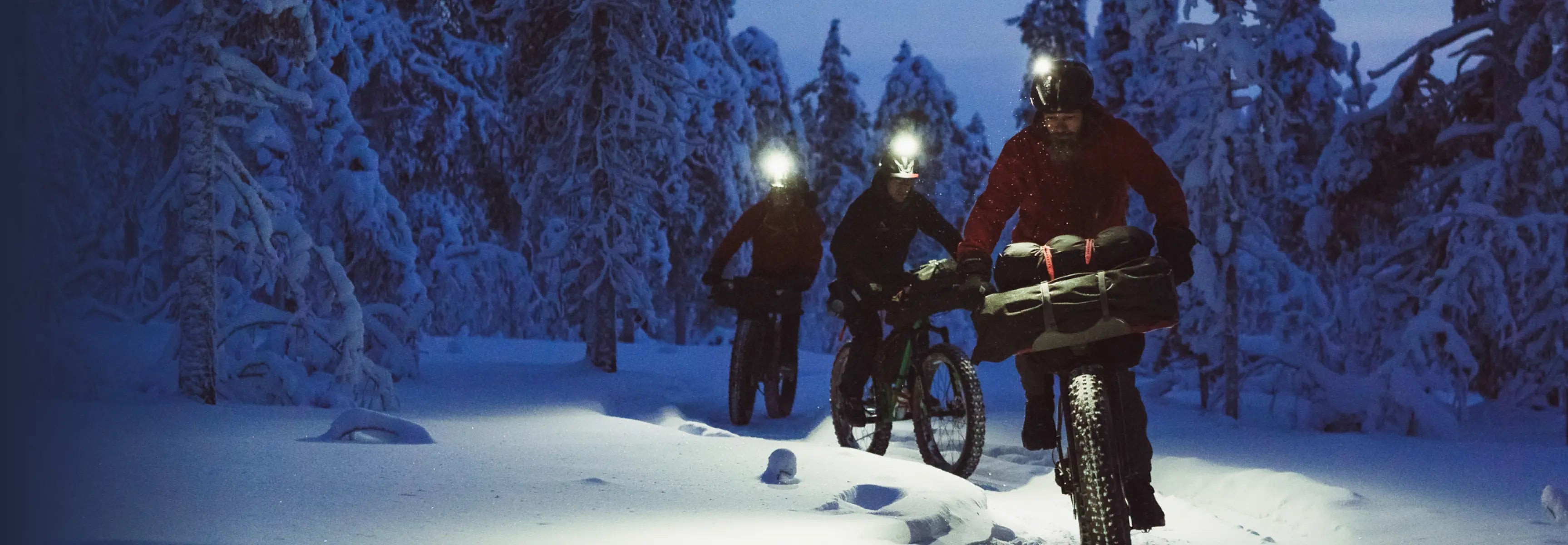
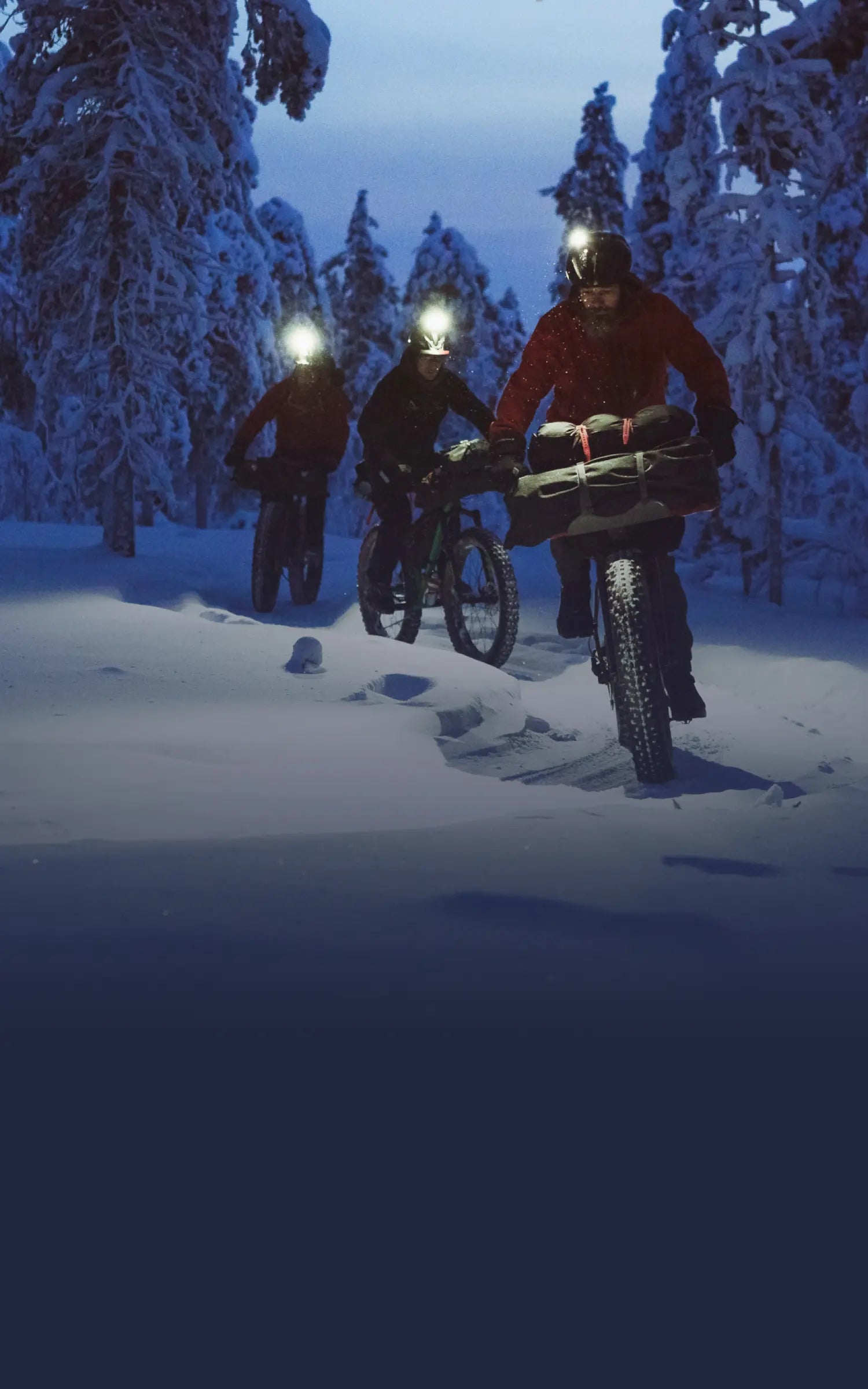
SUUNTOブログ
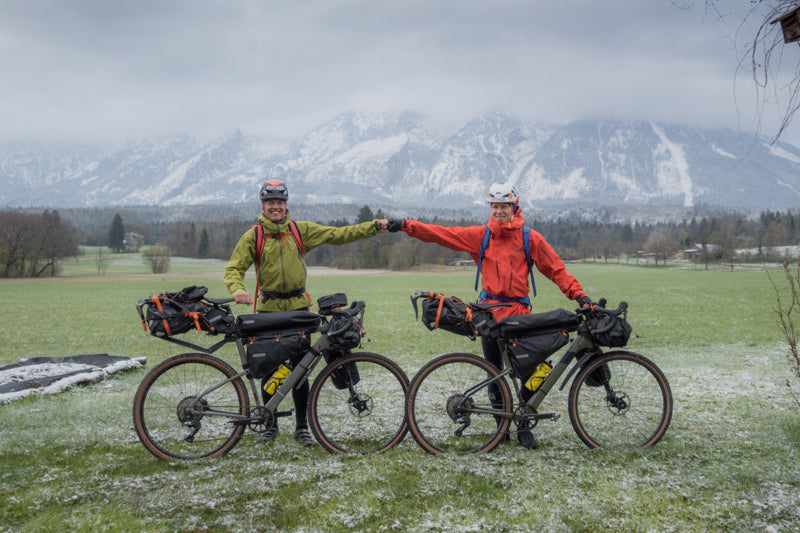
Two friends pursue history on the Eiger
Childhood buddies Philipp Reiter and Martin Schidlowski set off bikepacking from Berchtesgaden in south Germany yesteday following the same historic journey undertaken 85 years ago by German climbers and friends Toni Kurz and Andi Hinterstoisser.
In 1936, early in the Nazi period, Kurz and Hinterstoisser deserted from the German military, and under the cover of darkness began cycling from Berchtesgaden to the base of Eiger in Switzerland, some 600 km away. Their goal? To become the first climbing team to solve the last unsolved climbing problem in the Alps – the sheer, unforgiving North Face of the Eiger (3967 m). However, their climb ended in tragedy, with both climbers, and two Austrian climbers all dying on the wall. The tragic story was captured in the 2008 film, North Face.
“What is cool for me is we will get a little glimpse of an idea of how tough it was and what challenges Kurz and Hinterstoisserand had to face,” Philipp says. “It’s cool to discover how it really was for them.”
The intimidating North Face of Eiger. © Wikimedia Commons User: Terra3 / CC BY-SA 3.0
Philipp and Martin, both Berchtesgaden locals, are undertaking the same journey, with the aim of summitting Eiger via the North Face, to experience firsthand what their compatriots went through. It will take them three days to cycle 600 km, with 6000 m of vertical gain, to reach Grindelwald Valley and the base of the face where they will attempt the 1600 m vertical climb.
A snow dump made the first day a tough ride. @ Nicolas Holtzmeyer
Philipp, a photographer, alpinist and history enthusiast, and Martin, a climber and mountain guide, have been friends since childhood, and having been going on adventures together since 2006. Each year they try to share one adventure that combines endurance and mountaineering.
“Martin is totally not into biking,” Philipp says. “I’m more experienced with biking, and he’s expert in climbing. We make a good team. He’s afraid of the long bike ride, and I’m afraid of the challenging climb. This will be my biggest alpine project. It’s 1600 m straight up!”
The two friends will track their journey with Suunto watches and provide live updates via Suunto Instagram. @ Nicolas Holtzmeyer
This isn’t the first history focused adventure Philipp has initiated. In 2020, he and some friends did a relay run of the 850 km front line where Austrian and Italian troops battled during the First World War. In 2019, Philipp and his friends did the same on the 1400 km border that once divided Germany.
“Back in 1936 it was the Germans against the Austrians, and the Austrians against the Italians,” Philipp continues. “Climbing teams from each country wanted to become the first to scale the North Face. It created a super big hype, like the equivalant of a Superbowl TV broadcast.”
Philipp and Martin won’t have to cope with any competition or a medic circus, but a Bavarian television crew will follow them to document the historic journey. You can follow them on Suunto Instagram!

World Champion, World Record Holding, World Renowned Freediver Alenka Artnik Joins Team Suunto
In 2020 Alenka Artnik dived to 114m, deep beneath the surface of the Red Sea on a single breath, her mind and body working seamlessly together. Arriving on the surface fully aware and in control, Alenka claimed the title as the deepest female in freediving discipline CWT, Constant Weight, diving with a monofin.
Discovering the sport at a time in life when she needed inspiration and was ready for a change, Alenka was 30 and living in Slovenia when she hit the water running! Following a freediving session with friends, she quickly blew the other divers out of the water with her unearthly natural talent for apnea.
Alenka’s potential was identified early on by both her fellow divers and later her first instructor. Seizing the day, she packed her fins and moved to the vibrant diving hub of Dahab. Immersing herself in its freediving community, she found the bottom of the Blue Hole at about 100m on a breath-hold in her first season of training!
The new Suunto ambassador and freediving world champion Alenka Artnik summed up her passion for the sport with these words:
“We come from the sea and so it feels natural... It isn't just physical, it is mental, spiritual, and mind-blowing. I use the tool of freediving to explore my spirituality and carry it through into each part of my life.”
Eat, sleep, break dive record, repeat!
In 2016 Alenka celebrated her first World Record at the CMAS World Championships diving to 92m CWT wearing bi fins. The following year the record-breaking freediver won gold again at the same championships and graduated to the 100m club (CWT) at the Caribbean Cup, making her only the fourth female freediver to be crowned in the club.
Alenka, like so many other freedivers, has always dived with Suunto. Her Suunto D4i Novo was her first freediving computer, and now she dives with a Suunto D6i Novo, but soon she will be going deep with the D5. It is fair to say Suunto dive computers have always been at the centre of Alenka's training.
World Champion Alenka explained that she currently uses multiple Suunto devices when diving, "At the moment I'm using my two Suunto D6i Novo devices. One is for notifications of my depth that I wear on my neck weight close to my ear and the other I wear on my wrist so I can check my dives during training." She went on to say that analysing her dives afterwards is a key part of her dynamic training schedule and Suunto’s high performance in this area is one of the many reasons she chooses Suunto every dive, “I record all my dives in my training logbook with the help of the MEM Logbook function. I always rely on the logbook function of my Suunto dive computers to study my dives.”
Finding her flow
In recent years Alenk has continued to win competitions and break records but her focus has shifted from “winning” to a quest to optimize her performance, she summed it by saying “getting better motivates me.” The gains from this new approach are evident in her calm and collected surface protocols, something she attributes to entering the flow state, the world champion describes what she means by this:
“In the end, I think that it is all about the flow state. You put yourself in a mental state of flow. It is the peak performance, the maximum performance- but effortlessly.” summarises Alenka "For me, it is about how to do the best performance with the least effort possible. More with the mind and less with the physical effort. Good awareness, being super present the whole dive and less with the physical effort.”
100% commitment
Ten years on since Alenka discovered freediving, as she approaches 40 and with future hopes of freediving being billed at the Olympics, she is continuing with her hard push to dominate the depths with ease. Alenka is also part of a growing number of athletes in this discipline that are trying to demystify the sport, increase its popularity and ultimately help save our oceans.
“Freediving promotes a healthy lifestyle, but best of all more freedivers promotes more Ocean Ambassadors to protect our water planet.” Alenka Artnik
All images from Alenka Artnik ©
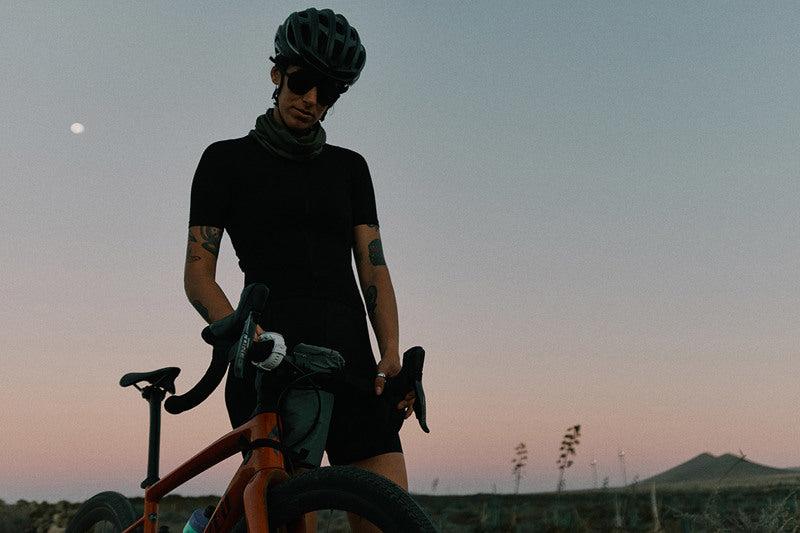
Don't miss a turn!
Bike adventurer Sami Sauri is no stranger to navigating on her bike. Currently she is working on guidebooks on gravel rides on the Spanish island of Fuerteventura. She is using komoot to plan the routes and her Suunto 9 to navigate and track them.
”I have several favorite features on komoot. For all users the highlights, that show community generated points of interest, and the way types, that show different surfaces, are some of the main things for planning routes,” Sami says. “And for the premium users the multi-day planner, dynamic weather forecasts and the collections are so good!”
With komoot you can choose and plan where to go either on a desktop or at the trailhead on your mobile device – and sync the planned route to your Suunto for navigation. Read on to learn more!
First things first: establish the connection
To get set up, simply connect your komoot profile with the Suunto app: Go to your profile on Suunto app and select ‘komoot’ under ‘Partner services’. Select ‘Connect with komoot’ and sign into your komoot account and allow requested permissions to connect.
As soon as you have connected the two accounts the sync is automatic both ways: your activities that are tracked with your Suunto are synced to komoot and the routes created on komoot are available on your route library on Suunto app.
Find routes on komoot
You can find a huge collection of pre-planned routes on komoot. You can search activity specific routes in a preferred location, use the routes your friends have shared or check out curated collections of routes for different themes or locations. Some examples of location and activity specific collections are “Best mountain hikes in Haute-Savoie” and Sami's own "Fuerteventura Gravel Route Guide". The themed collections can cover topics like “Long-distance hiking trails”.
Plan your own routes on komoot
First of all, komoot’s route planning is sport specific. When you are planning a route from point A to point B, you are likely to get different results depending on the activity type you choose. For example, for a bike tour you can select between road cycling, bike touring, gravel riding, mountain biking and enduro mountain biking. As the type of riding changes, so does the route it follows.
While planning a route you can view user generated, sport specific highlights on the map that you can include on your route when planning. You can also select POIs, like campgrounds, restaurants etc., to be visible on the map when planning.
Additional nice details include topics like a surface type overview, altitude profile and a dynamic weather forecast: Simply select the time when you want to start your tour and the weather forecast is updated accordingly. That’s quite useful with temperatures in the mountains and wind for a road cycling tour, for example.
Other useful features include sharing route plans with friends, planning multi day itineraries and creating your own route collections.
Navigate with your Suunto
Once you have created a route (called a ‘tour’ in komoot language) it will automatically be synced to your Suunto account. To use it for navigation switch the ‘use in watch’ toggle on and sync your watch with the Suunto app.
A key benefit for creating routes for your Suunto on komoot is turn-by-turn navigation: When navigating, the watch will alert you about an upcoming turn. This makes the navigation experience more enjoyable, as you don’t need to keep an eye on the navigation screen to see which way to take. There is one alert 100 meters before a turn and one at the turn. (komoot's turn alerts are shown on Suunto 9, Suunto 7 and Suunto 5 watches. With Spartan family no direction is shown, there is only an alert that you need to turn.)
You will get a free map region on komoot when you connect your accounts and can start using the turn-by-turn navigation for routes in that region. When buying a new Suunto watch you will get additional two free map regions from komoot as part of Suunto Valuepack!
Learn more about komoot at komoot.com. Multi-day planner, personal collections, on-tour weather, sport-specific maps and worldwide offline maps are komoot premium features.
Action images by Sergio Villalba
Watch now: Getting started with komoot
Read more
Six ways to plan a route for your next adventure
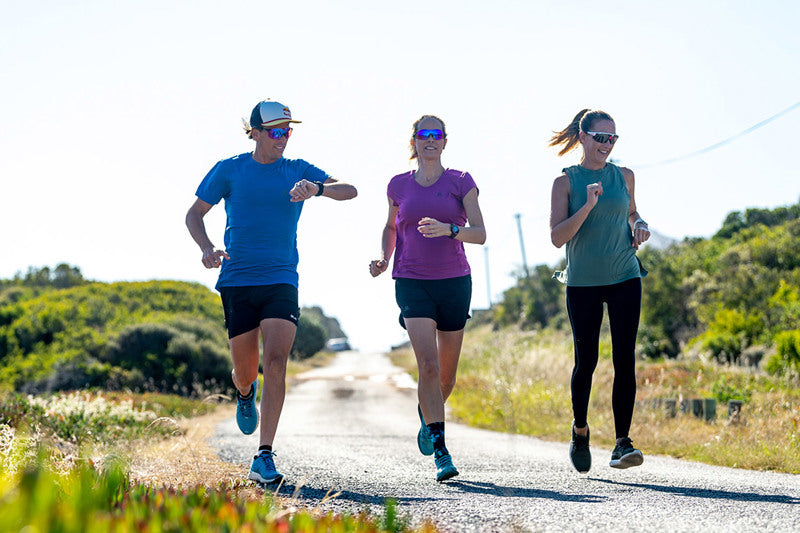
9 training tips for the Wings for Life World Run
One race you can definitely count on happening this year is the Wings for Life World Run. To be held on May 9, it will be a virtual race with app-based events happening in more than 70 locations around the world. Lock it into your race calendar because it’s going to be fun and for an awesome cause – 100% of the entry fees goes to finding a cure for spinal injury.
Suunto ambassador Ryan Sandes is also ambassador for the race and the captain of Team Suunto in the event. Every year, when he’s not off racing somewhere hardcore, he’s pumped to run it because of the fun atmosphere, the thrill of being chased by the Catcher Car, and because he feels passionate about running for those who can’t due to spinal injuries.
Who better to ask then about how to prepare for the unique race? We caught up with Ryan and asked how he approaches it. “The cool thing with this race is the finish line is constantly moving according to the speed you’re running,” Ryan says. “Whereas with a marathon, you know you will run 42.2 km. Preparation wise this does change things a little.”
Read on for Ryan’s nine tips!
Choose a goal
With that moving finish line it’s helpful to choose a distance you aim to run in the race. Maybe that’s a 10k, a 30 km, a marathon, or going ultra distance. “Make that distance the focus of your training,” Ryan says.
Use the official race Goal Calculator to determine how long, in terms of duration, you’ll run to achieve your desired distance, as well as the pace you’ll need to maintain.
Go trail
As a passionate trail runner, and like all trail runners being wary of road running, Ryan says preparing for the race shouldn’t stop you training off road if that’s more your schtick. With this year’s race being held virtually via the Wings for Life World Run App, it doesn’t matter where you run. But choose flatter, flowing trails so the Catcher Car doesn’t have too much of an advantage over you.
Get road ready
Wings for Life World Run races are usually held in urban locations that involve plenty of asphalt. If your goal is to stay ahead of the Catcher Car for as long as possible, then Ryan recommends getting used to running on the road and doing the race that way.
Two key sessions
When Ryan trains for the Wings for Life World Run he focuses on two key training runs a week: one interval or fartlek session and one long run with stride bursts. Let’s look at each more closely.
Interval or fartlek session: Fartlek is the Swedish word for “speed play”, and basically refers to a form of running training when you mix up the speeds you run at. Interval training is basically the same, but the focus is on running high intensity segments interspersed with a slower pace.
Ryan recommends, depending on your fitness level, doing one of the following:
– four eight-minute intervals
– four six-minute intervals
– four three-minute intervals
Each interval should be a notch or two faster than your usual long run pace. Make sure you warm up first before starting them and be careful not to overdo them. You should have a good level of running fitness before trying them because it’s not uncommon for runners to get injured while doing interval training.
The long run with stride bursts: Long runs can be anywhere from an hour, to three hours or longer, and the crucial point is to remember that to gain the physiological adaptations they can offer over time it’s essential to do them at an easy pace. Ryan recommends doing one long run a week and adding a little twist if you’re ready for an extra challenge – doing strides.
Stride bursts, commonly called strides, involve running at 90 or 95% of your max pace in short bursts. Try doing six to eight 10 to 15-second long strides in the middle of your long run. These are an excellent way to improve speed and coordination.
Use the Catcher Car training feature with your Suunto
Why wait to race day to know how you’ll do against the Catcher Car? Thanks to the partnership between Suunto and Wings for Life World Run you don’t have to. The partnership resulted in the Catcher Car training feature available on Suunto 5 and Suunto 9 watches.
It enables users to train against a digital version of the iconic Catcher Car, so you’re ready to take on the real thing come race day. You’ll see how far back the Catcher Car is, and the estimated distance and time duration left before it catches you.
Ryan also recommends using it on race day: “I use the Catcher Car feature on race day because it’s really cool to be able to look at your watch and see how far you are from the Catcher Car.”
Try barefoot running
“Something else I’d do is a little barefoot running on a rugby or soccer field, just 10 to 15 minutes once a week to strengthen your feet and lower legs,” Ryan says. “Because I find when I run on the road my calves get quite fatigued and tired.”
Stay mobile
If you’re like Ryan and more of a trail runner and mountain athlete, then the repetitive motion of road running can be tough on the body. Over time it’s easy to lose mobility in key joints, especially the hips, back and shoulders.
Ryan recommends doing dynamic stretching, mobility work or yoga to ensure you keep moving well.
Get people involved
Wings for Life World Run, like Suunto, is all about community. It’s a run we do together for the benefit of others. So, Ryan suggests signing up as many friends and family members as possible, both for your training and the race, and to join Team Suunto to raise money for spinal cord injury research.
“It’s such an awesome cause,” Ryan says. “It’s a really fun and dynamic event so team up with some friends for some of your training and try to get people involved. Even if it’s just doing an easy run with a friend once a week.”
Be smart on race day
The race starts at 11:00 UTC, which is 11:00 AM in London, 12:00 PM in Berlin, 7 PM in Beijing, and 10 PM in Sydney. Depending on where you are in the world this means you’ll need to manage race day accordingly.
“Maybe where you are you’'ll be running at night so get used now to running with a headlamp,” Ryan says. “If you’re running in the afternoon sun make sure you stay hydrated. Plan your mealtimes relative to the race time; don’t race on a full stomach or when you’re hungry. When I ran it in Melbourne the race started in the evening so it’s important to stay hydrated throughout the day, to keep eating, and maybe do some mobility exercises to stay loose.”
Images by Craig Kolesky
READ MORE
5 reasons to run in the Wings for Life World Run
Race the Catcher Car with Suunto
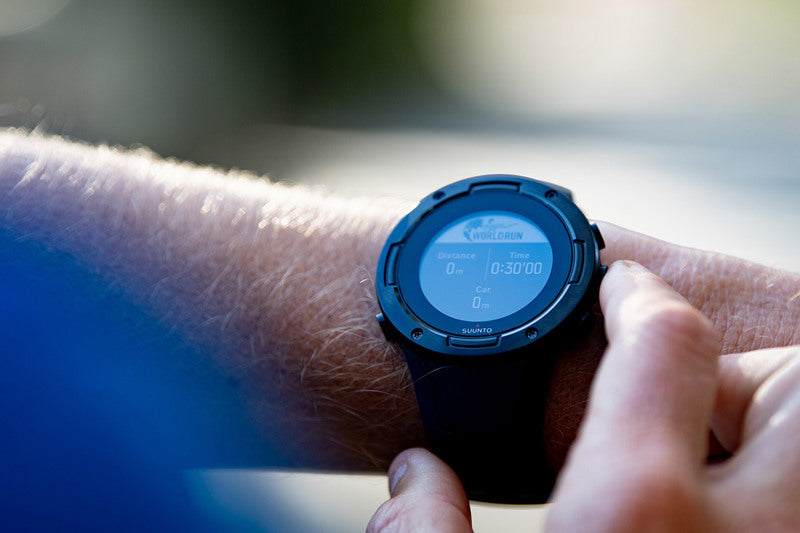
Race the Catcher Car with Suunto
Training for the Wings for Life World Run is now fun and easy with the Catcher Car training feature available on Suunto 5 and Suunto 9 watches.
Wings for Life World Run is a unique race that raises funds to find a cure for spinal cord injury. There is no finish line. Instead, you start with thousands of people worldwide at the same time, running as far as you can before the Catcher Car passes you.
The training feature enables users to train against a digital version of the iconic Catcher Car, so you’re ready to take on the real thing come race day. You’ll see how far back the Catcher Car is, and the estimated distance and time duration left before it catches you.
Like Suunto ambassador Ryan Sandes,you can also use it on race day to know how far behind you the virtual Catcher Car is. “Being chased by the Catcher Car anywhere, anytime thanks to this new watch feature is going to add an exciting new dimension to training!” Ryan says.
How to use the Suunto training feature
The virtual Catcher Car begins pursuit 30 minutes after you start, gradually speeding up as it tries to catch you. As you run, you can see how far back it is, and the estimated distance and time duration you will run before it catches you.
To use the Wings for Life feature with your Suunto 5 or Suunto 9:
Select your preferred activity type and, before pressing the start button, scroll down for ‘options’.
Select ‘SuuntoPlus’ in the options.
Select ‘Wings for Life World Run’
Scroll back up to the start view and start your exercise as normal.
During your exercise, swipe left or press the middle button until you reach the Wings for Life World Run display.
After you have ended the exercise, you can find the Wings for Life World Run result as part of the summary.
Images by Craig Kolesky
READ MORE
9 training tips for the Wings for Life World Run
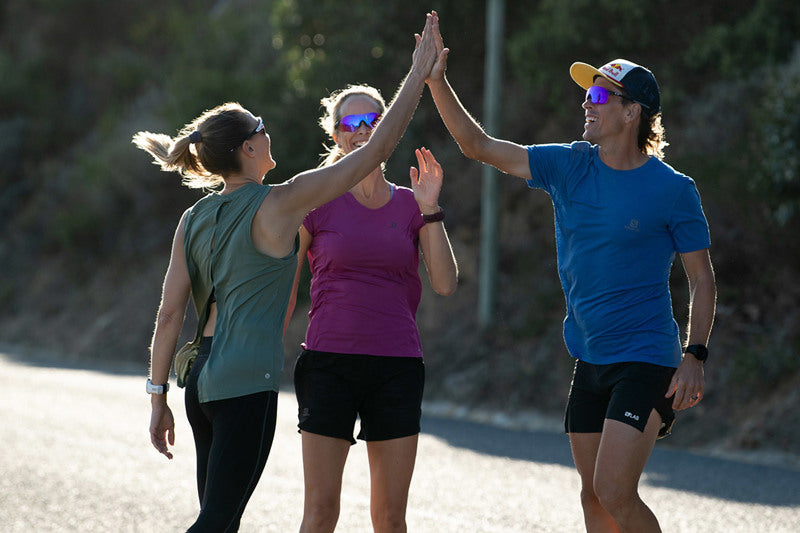
5 reasons to run in the Wings for Life World Run
The Wings for Life World Run is an annual fixture for many runners, including Suunto ambassador Ryan Sandes. “It’s an amazing event and it’s cool to be able to give back through the sport of running, which has given me so much,” he says.
Ryan will be competing in the 2021 virtual edition of the race, to be held on May 9, and is calling for his fellow trail and ultra runners to join him. “It’s a special race with a really cool vibe,” he says. If you need more convincing, read on for Ryan’s five reasons to run it.
Give back through running
“It’s a good feeling being able to run for those who can’t,” Ryan says. “One hundred percent of the entry fees go towards spinal cord injury research and trying to find a cure.”
Two-time motocross world champion Heinz Kinigadner and the Red Bull founder Dietrich Mateschitz established the Wings for Life foundation in 2004. Ever since, it’s been funding research and studies on spinal cord injury.
Your entry fee contributes to their goal of finding a cure.
The thrill of the chase
Held every year since 2014, the Wings for Life World Run offers an extra layer of fun and excitement compared to ordinary races. Rather than running to a finish line, a Catcher Car begins chasing the participants 30 minutes after the race starts. As it passes each participant, their race is over.
This means the race has no set distance. More experienced runners will run further, slower runners will run less. Last year’s winner, Michael Taylor of Great Britain, outpaced the Catcher Car for a distance of 69.92km, but the important thing is participation. Everyone sets their own goals, and everyone finishes the race.
You can count on it
With the pandemic still raging there is so much uncertainty about which races will happen in 2021. One race you can count on is the Wings for Life World Run. This year it will be a virtual race. Simply download the Wings for Life World Run App and decide how you want to run: on your own or with a virtual team. It doesn’t matter where you are living, you can start running with all the participants worldwide at the same time and you will be chased by the virtual Catcher Car.
So add the date, May 9 to your calendar now and join Suunto Wings for Life World Run Team!
There’s tools to help you train
In 2020, Suunto and the Wings for Life World Run partnered and created a new Catcher Car training feature for Suunto 5 and Suunto 9 watches. Designed to support runners training for the race, the feature enables them to train against a digital version of the Catcher Car, right on their wrist. They’ll see how far back the Catcher Car is, and the estimated distance and time duration left before it catches them.
Get that community vibe
Aside from the good cause and the fun of the chase, the community vibe is what draws runners back year after year to the race.
While 2021 is different, there are now more than 1,300 virtual teams and 70 Organized App Runs all over the world, and even those who run on their own are connected to the community through the App.
Visit the Wings for Life World Run website to learn more and sign up!
All images by Craig Kolesky










































































